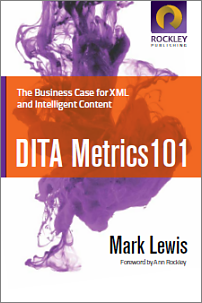Table of Contents
Introduction
- Benefits
- Who should read this book
- At what level is this book written
- How this book came to be
- Before you start
- How to use this book
- Sample use case
- Filtering and reuse
Topic Metrics 101
Project Metrics 101
Translation Metrics 101
- Translation savings from reuse
- Calculating translation hours
- Cost of translation
- Translation dollars and multiple languages
Topic Metrics 102
Project Metrics 102
- Project using detailed topic models
- Writing for reuse and identical topics
- Project using identical topics
Content reuse (referencing)
- Use case example
- Using warehouse topics
- Warehouse topic cost model
- Project using warehouse topics
- Savings using warehouse topics
- Cost of translating warehouse and referencing topics
- Component based translation
- Conclusion
Content filtering
- Use case example
- Using master topics
- Master topic cost model
- Project using master topics
- Savings using master topics
Structured Authoring Metrics
- As percent reuse increases
- Cost of formatting
- Cost of maintenance
- Conclusion
Translation Metrics 102
- Translation costs
- Translation without reuse
- Factors that affect translation speed
- Translation with reuse
- Cost of desktop publishing
- Content references (conref)
- Conclusion
Production Metrics
Production Metrics: Tracking Actuals
- Executive Questions
- Manager Questions
- Definitions and ideas
- Conclusion
- Summary: The benefits of DITA based on metrics
- Proving the savings
- Supporting the business plan
Glossary
Index
|

Order the Book
DITA Metrics 101 is now available for purchase at Lulu.com.
DITA Metrics 101 Companion Workbook
A companion workbook is available. It contains all the spreadsheets referenced in the book and is available for purchase and immediate download.
Get the Workbook now!

|